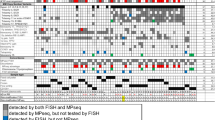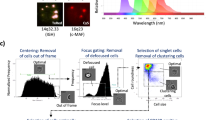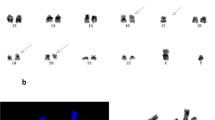Abstract
Interphase fluorescence in situ hybridization (iFISH) is increasingly used for the identification of BCR/ABL gene rearrangements in chronic myeloid leukemia (CML) and acute lymphoblastic leukemia (ALL). In the present study, we have explored the incidence of both typical and atypical iFISH patterns of BCR/ABL gene rearrangements in a series of 168 consecutive BCR/ABL+ patients – 135 CML, 31 precursor B-ALL and two acute myeloblastic leukemia (AML) cases – and established their underlying genetic alterations through further molecular and chromosome analyses. Two different FISH probes (Vysis Inc., Downers Grove, IL, USA) were used: the LSI BCR/ABL dual color extra signal (ES) and the dual color dual fusion BCR/ABL probe (D-FISH). Our results show that most BCR/ABL+ patients (83%, including 88% of all CML, 61% of ALL and one of two AML) displayed typical iFISH patterns of either Major (M) BCR/ABL (87% of CML, 13% of ALL and one of the two AML) or minor (m) BCR/ABL gene rearrangements (1% of all CML and 48% of ALL cases) with the two probes. Further molecular and cytogenetic studies confirmed the presence of such typical rearrangements in all except one of these ALL cases who had coexistence of an MBCR/ABL and an mBCR/ABL gene rearrangement together with monosomy 9. In the remaining 29 cases (17%), up to five different atypical iFISH patterns were detected with the ES probe. Atypical iFISH patterns were most frequently due to additional numerical changes – most often supernumerary Philadelphia (Ph) chromosome (7%) but also gain or loss of chromosome 9 (1%) or 22 (1%). Deletion of 9q sequences proximal to the breakpoint were also frequently observed with the ES probe (8%). Application of the D-FISH probe showed that in most of these latter cases (5%) deletion of 22q sequences distal to the breakpoint also occurred. The remaining cases with atypical iFISH had cryptic insertion of BCR in 9q34 (1%). Exact interpretation of each iFISH pattern was supported by FISH on metaphases and molecular determination of the BCR breakpoint. In summary, our results indicate that despite the high incidence of typical iFISH patterns of BCR/ABL gene rearrangements, atypical patterns are also found in BCR/ABL+ acute leukemias; the precise definition of the alteration present in individual cases is dependent on metaphase studies and molecular definition of the breakpoint.
This is a preview of subscription content, access via your institution
Access options
Subscribe to this journal
Receive 12 print issues and online access
$259.00 per year
only $21.58 per issue
Buy this article
- Purchase on Springer Link
- Instant access to full article PDF
Prices may be subject to local taxes which are calculated during checkout


Similar content being viewed by others
References
Rowley JD . Letter: a new consistent chromosomal abnormality in chronic myelogenous leukaemia identified by quinacrine fluorescence and Giemsa staining. Nature 1973; 243: 290–293.
Bartram CR, Carbonell F . bcr rearrangement in Ph-negative CML. Cancer Genet Cytogenet 1986; 21: 183–184.
Ganesan TS, Rassool F, Guo AP, Th'ng KH, Dowding C, Hibbin JA et al. Rearrangement of the bcr gene in Philadelphia chromosome-negative chronic myeloid leukemia. Blood 1986; 68: 957–960.
Shtalrid M, Talpaz M, Blick M, Romero P, Kantarjian H, Taylor K et al. Philadelphia-negative chronic myelogenous leukemia with breakpoint cluster region rearrangement: molecular analysis, clinical characteristics, and response to therapy. J Clin Oncol 1988; 6: 1569–1575.
Secker-Walker LM . Prognostic and biological importance of chromosome findings in acute lymphoblastic leukemia. Cancer Genet Cytogenet 1990; 49: 1–13.
Melo JV . The molecular biology of chronic myeloid leukaemia. Leukemia 1996; 10:751–756.
Garcia-Isidoro M, Tabernero MD, Garcia JL, Najera ML, Hernandez JM, Wiegant J et al. Detection of the Mbcr/abl translocation in chronic myeloid leukemia by fluorescence in situ hybridization: comparison with conventional cytogenetics and implications for minimal residual disease detection. Hum Pathol 1997; 28: 154–159.
Sinclair PB, Nacheva EP, Leversha M, Telford N, Chang J, Reid A et al. Large deletions at the t(9;22) breakpoint are common and may identify a poor-prognosis subgroup of patients with chronic myeloid leukemia. Blood 2000; 95: 738–743.
Dewald GW, Wyatt WA, Juneau AL, Carlson RO, Zinsmeister AR, Jalal SM et al. Highly sensitive fluorescence in situ hybridization method to detect double BCR/ABL fusion and monitor response to therapy in chronic myeloid leukemia. Blood 1998; 91: 3357–3365.
Bentz M, Cabot G, Moos M, Speicher MR, Ganser A, Lichter P et al. Detection of chimeric BCR-ABL genes on bone marrow samples and blood smears in chronic myeloid and acute lymphoblastic leukemia by in situ hybridization. Blood 1994; 83: 1922–1928.
Dewald GW, Wyatt WA, Silver RT . Atypical BCR and ABL D-FISH patterns in chronic myeloid leukemia and their possible role in therapy. Leuk Lymph 1999; 34: 481–491.
Rieder H, Bonwetsch C, Janssen LA, Maurer J, Janssen JW, Schwartz S et al. High rate of chromosome abnormalities detected by fluorescence in situ hybridization using BCR and ABL probes in adult acute lymphoblastic leukemia. Leukemia 1998; 12: 1473–1481.
Herens C, Tassin F, Lemaire V, Beguin Y, Collard E, Lampertz S et al. Deletion of the 5′-ABL region: a recurrent anomaly detected by fluorescence in situ hybridization in about 10% of Philadelphia-positive chronic myeloid leukaemia patients. Br J Haematol 2000; 110: 214–216.
Huntly BJ, Reid AG, Bench AJ, Campbell LJ, Telford N, Shepherd P et al. Deletions of the derivative chromosome 9 occur at the time of the Philadelphia translocation and provide a powerful and independent prognostic indicator in chronic myeloid leukemia. Blood 2001; 98: 1732–1738.
Bennett JM, Catovsky D, Daniel MT, Flandrin G, Galton DA, Gralnick H et al. The chronic myeloid leukaemias: guidelines for distinguishing chronic granulocytic, atypical chronic myeloid, and chronic myelomonocytic leukaemia. Proposals by the French–American–British Cooperative Leukaemia Group. Br J Haematol 1994; 87: 746–754.
Harris NL, Jaffe ES, Diebold J, Flandrin G, Muller-Hermelink HK, Vardiman J et al. World Health Organization classification of neoplastic diseases of the hematopoietic and lymphoid tissues: report of the Clinical Advisory Committee meeting-Airlie House, Virginia, November 1997. J Clin Oncol 1999; 17: 3835–3849.
Bene MC, Castoldi G, Knapp W, Ludwig WD, Matutes E, Orfao A et al. Proposals for the immunological classification of acute leukemias. European Group for the Immunological Characterization of Leukemias (EGIL). Leukemia 1995; 9: 1783–1786.
Hernandez JM, del Canizo MC, Cuneo A, Garcia JL, Gutierrez NC, Gonzalez M et al. Clinical, hematological and cytogenetic characteristics of atypical chronic myeloid leukemia. Ann Oncol 2000; 11: 441–444.
Maillo A, Diaz P, Sayagues JM, Blanco A, Tabernero MD, Ciudad J et al. Gains of chromosome 22 by fluorescence in situ hybridization in the context of an hyperdiploid karyotype are associated with aggressive clinical features in meningioma patients. Cancer. 2001; 92: 377–385.
Chomczynski P, Sacchi N . Single-step method of RNA isolation by acid guanidinium thiocyanate–phenol-chloroform extraction. Anal Biochem 1987; 162: 156–159.
van Dongen JJ, Macintyre EA, Gabert JA, Delabesse E, Rossi V, Saglio G et al. Standardized RT-PCR analysis of fusion gene transcripts from chromosome aberrations in acute leukemia for detection of minimal residual disease. Report of the BIOMED-1 Concerted Action: investigation of minimal residual disease in acute leukemia. Leukemia 1999; 13: 1901–1928.
Kantarjian HM, Keating MJ, Talpaz M, Walters RS, Smith TL, Cork A et al. Chronic myelogenous leukemia in blast crisis. Analysis of 242 patients. Am J Med 1987; 83: 445–454.
Kantarjian HM, Talpaz M, Dhingra K, Estey E, Keating MJ, Ku S et al. Significance of the P210 versus P190 molecular abnormalities in adults with Philadelphia chromosome-positive acute leukemia. Blood 1991; 78: 2411–2418.
van Rhee F, Hochhaus A, Lin F, Melo JV, Goldman JM, Cross NC . p190 BCR–ABL mRNA is expressed at low levels in p210-positive chronic myeloid and acute lymphoblastic leukemias. Blood 1996; 87: 5213–5217.
Williams BG, Yin JL, Ma DD . A Ph+acute myeloid leukaemia expressing both CML-type and ALL-type BCR/ABL mRNA transcripts. Leuk Lymph 1994; 14: 341–346.
Abruzzese E, Pettenati MJ, Cox K, Jackle B, Watts RG, Carroll AJ et al. Identification of BCR–ABL fusion on chromosome 9 by fluorescence in situ hybridization in two chronic myeloid leukemia cases. Cancer Genet Cytogenet 1998; 105: 164–167.
Acknowledgements
MD Tabernero is supported by a grant from the MCYT, programa Ramón y Cajal. JM Sayagues is supported by a grant (02/9103) from Ministerio de Sanidad y Consumo, Madrid, Spain.
Author information
Authors and Affiliations
Rights and permissions
About this article
Cite this article
Primo, D., Tabernero, M., Rasillo, A. et al. Patterns of BCR/ABL gene rearrangements by interphase fluorescence in situ hybridization (FISH) in BCR/ABL+ leukemias: incidence and underlying genetic abnormalities. Leukemia 17, 1124–1129 (2003). https://doi.org/10.1038/sj.leu.2402963
Received:
Accepted:
Published:
Issue Date:
DOI: https://doi.org/10.1038/sj.leu.2402963
Keywords
This article is cited by
-
Investigating residual leukemic cells in acute lymphoblastic leukemia: a practical approach using a streamlined interphase fluorescence in situ hybridization method on cerebrospinal fluid
Molecular Cytogenetics (2023)
-
Chronic myeloid leukemia with insertion-derived BCR–ABL1 fusion: redefining complex chromosomal abnormalities by correlation of FISH and karyotype predicts prognosis
Modern Pathology (2020)
-
Heterogeneous BCR-ABL1 signal patterns identified by fluorescence in situ hybridization are associated with leukemic clonal evolution and poorer prognosis in BCR-ABL1 positive leukemia
BMC Cancer (2019)
-
An unusual case of high hyperdiploid childhood ALL with cryptic BCR/ABL1 rearrangement
Molecular Cytogenetics (2014)
-
Application of tri-colour, dual fusion fluorescence in situ hybridization (FISH) system for the characterization of BCR-ABL1 fusion in chronic myelogenous leukaemia (CML) and residual disease monitoring
BMC Hematology (2009)



